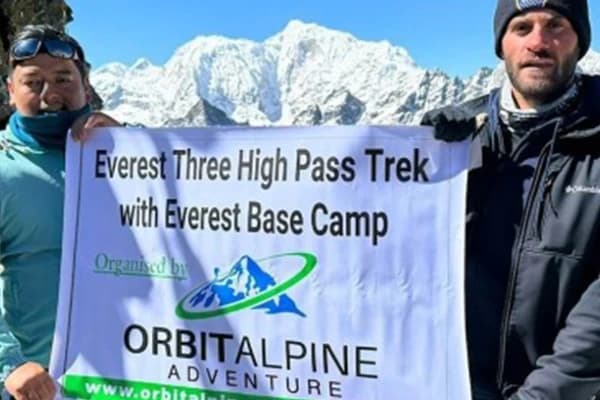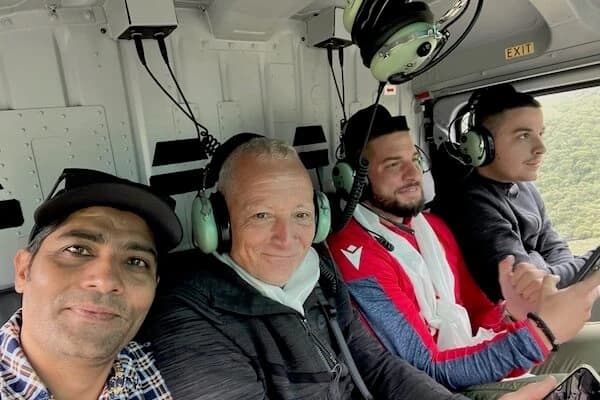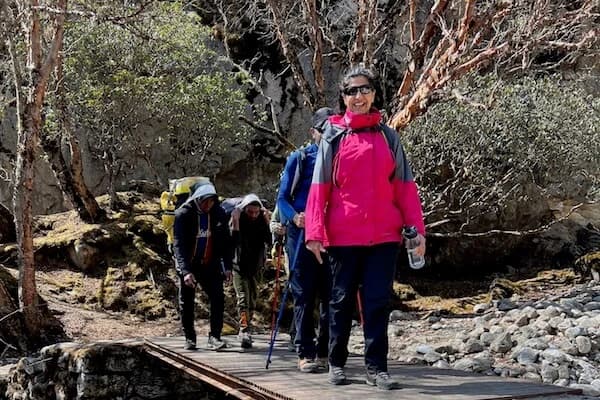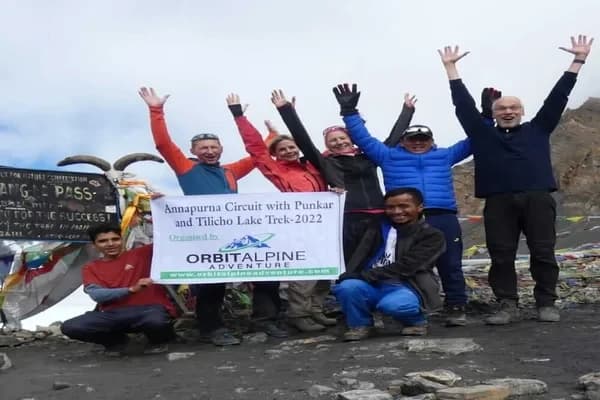The Everest three-high passes trek is an adventurous and challenging trekking trail nestled around the Everest region. The name of this beautiful trek comes from the three famous passes; Kongma La (5535m), Ranjo La (5360m), and Cho La (5420m). This trek is designed for experienced trekkers and nature worshippers looking for an immersive Himalayan experience
How Difficult Is the Everest Three High Passes Trek
This trek is not only challenging but also offers special gifts for those who dare to do it. The most important of all is the view of towering eight thousanders like Everest, Ama Dablam, Nuptse, Lhotse, and Makalu.
In addition, you can also witness numerous glaciers, icefalls, high-altitude lakes, Sherpa sites, and Stupas, as well as lush forests adding more beauty to this magical land.
However, several undeniable factors are crucial in Everest's three high passes trek’s difficulty. The most obvious is its high altitude, challenging terrains, and extreme weather conditions.
In this blog, we will understand the Everest three-pass trek including the challenges it has to offer. Also, we will provide expert insights and tips for completing a successful trek.
Understanding the Everest Three High Pass Trek
This trek usually spans for about 18-21 days starting and ending at Lukla. Lukla is the main trading hub of the Khumbu region easily accessible by a short flight from Kathmandu.
Key features and Highlights of the trekking route
Three High Mountain Passes:
As the name suggests, the major highlights of this trek are three high passes Kongma La Pass, Renjo La Pass, and Cho La Pass. These three different passes are all over five thousand meters and offer a different perspective of the beauty of the Everest region.
Kogma La Pass is the highest of the three passes and offers a spectacular view of peaks like Loubuche and Pumori. It connects Khumbu Valley to the Imja Tse Valley passing through steep ascent and descent often requiring the use of the ropes.

On the other hand, Renjo La Pass is best known for its exceptional panoramic view. It links the Gokyo Valley and Bhote Koshi Valley offering stunning perspectives on Mt Everest, Lhotse, Cholatse, and the pristine Gokyo Lakes.
Cho La Pass provides the trekker with a unique experience and connects the villages of Dzongla and Thangnak. This same route also connects the Everest Base Camp and Gokyo Lake. This pass involves trekking on an icy path navigating a glacier often using crampons.
Everest Base Camp and Kalapatthar
Everest Three High Passes Trek also includes a visit to two legendary and most famous destinations of the region.
Visiting EBC creates a unique memory for a lifetime at the foot of the world’s highest mountain. An iconic site bustling with climbers and decorated with colorful prayer flags, trekkers can soak into the majestic views of Khumub Icefall and surrounding giants.
Kala Patthar is arguably the best viewpoint for Mount Everest which offers breathtaking sunrise and sunset view over the world’s highest peak.
Gokyo Lakes and Gokyo Ri
This trek also includes a visit to the bright turquoise Gokyo Lakes, a series of six of the world’s freshwater lake systems in the world.
Gokyo Ri (5357m) is a spectacular viewpoint that offers a clear view of Cho Oyu, Everest, Lhotse, Malaku, and Gokyo lakes.
Sherpa Villages, monasteries, and Culture
Everest high pass trek takes you through Sherpa settlements like Namche, Phakding, Tengboche, Chhukung, etc. This gives the trekkers a chance to experience the Sherpa life, hospitality, cuisines, and customs. These villages are decorated beautifully with carved mani stones, colorful prayer flags, and monasteries that reflect the heritage of the Sherpa people.

Challenging Terrains and Remote Trails
The main fun of this trek is its challenging structure that will take you through the high-altitude passes and steep climbs. Trekkers have to navigate through rocky landscapes, glacial passes, and icy slopes too.
But, apart from the difficulties, trekking on a path far from the crowd will give trekkers a peaceful and serene experience.
Physical difficulties during the three-pass trek
Several factors play an important role in adding brick to Everest's three high pass trek difficulties.
The first factor is the duration and the trekking distance. Imagine trekking for 18-21 days on high-altitude trekking trails. The average trekking hour per day is between six and eight hours and this can increase for some days.
We can witness significant changes in elevation throughout the trek. All three passes include steep ascents and descents which can be exhausting both physically and mentally.
Each pass demands its kind of difficulties. Kongma La being the highest of all features a steep, rocky climb and icy conditions. Cho La Pass is known for its glacier crossing. There is a high chance the trail can be slippery and requires the technical skill of using crampons and ice axes too.
The Best weather for Everest Three High Passes trek
Unlike other trekking, this is a high-altitude trek. Hence, the impact of weather that might seem normal or bearable for other treks, won't look the same in this trek.
Even if you can bear the impacts physically, nature won’t. They will not be able to offer their best to you during unfavorable weather conditions. So you should be careful enough to plan your trek during on-seasons to nullify the impact of bad weather.
Then what are the best seasons and which are the seasons that increase the difficulty of Everest three high pass trek?
Weather conditions in Spring Season (March-May)
Spring can be considered one of the best seasons for Everest's three-high pass trek. This is also one of the peak seasons for trekking and mountaineering in the Everest region.
During this time of the year, temperature is warm fluctuating between 15℃ to 25℃. Which makes trekking during the long days of Spring pleasant. But the temperature drops down in the higher altitudes and before sunrise and after it gets darker.
The sky stays clear offering a clear view of surrounding vistas. That offers a breathtaking view of sky-high mountains, glaciers, and forests with blooming Rhododendrons, and pine trees.
The trails of this region won't be affected by any weather-related challenges. That allows you to trek on wet and easy trails.
However, the early phase of the Spring season is the transition month. If you are planning your trek during this time, you won't regret being prepared for some occasional snowfall.
Weather Condition During Autumn Season
Autumn season starts in September and lasts till December in Nepal. During autumn, the trails leading to the high passes will give you the chance to gaze into the best version of the Everest region.
Starting right after the monsoon season, there are still some greens remaining adding contrast to the rugged landscapes. The trails are dry and in good condition which reduces the risk of slippery paths and landslides.
With the post-monsoon landscapes, this season offers to witness the Himalayas flora and possibly some wildlife too.
The sky is clear so are the surrounding views too. You can lose yourself in the beauty of mountains like Everest, Lhotse, Nupste, Cho Oyu, etc without any hindrance.
The temperature during the daytime is cool which keeps you out of complaining about the weather while trekking. However, the mornings and nights are still cold.
Overall, this season provides some of the clearest and most predictable weather, which is important for safe high-altitude trekking.
Trekking in Winter and Summer Seasons
Trekking in winter and summer around the Everest High Passes presents extreme challenges.
Winter (December-February) brings extreme cold while trekking around the Everest region. The temperature often drops below the freezing points, especially around the high altitudes and during the night.
Heavy snowfall covers the trails making the trails invisible, more difficult to trek, and sometimes dangerous too. Passes and Ri like Kongma La, Renjo La, Cho La, and Gokyo Ri require additional mountaineering equipment and climbing skills too.
Likewise,
The Summer (June-August) season coincides with the Monsoon season in Nepal. So, the continuous rainfall makes the trails super slippery increasing the difficulty of the trek. The risk of landslides makes this season even worse for trekking.
Another frustrating thing about this trek is the lack of visibility due to frequent clouds and fog. There is no point in doing this trek but not being able to enjoy the grand views that make the trek so famous.
Some of the Available Treks:
Everest Base Camp Helicopter Tour
Everest Base Camp Trek with Helicopter Return
Physical Fitness and Training
If you want to complete and enjoy this trek without any struggle, you have to stay in excellent physical condition. This is the only way you can ease the difficulty of the Everest three high passes trek.
There are certain physical horizons to meet and training to do to stay prepared for the challenges this trek has to offer.
Cardiovascular Training
Trekking is not an easy job itself. Trekking in the high altitudes climbing and descending 5000m+ passes is not an easy job.
You need a strong cardiovascular system to prevent altitude sickness, increase stamina, and improve the efficiency of overall trekking. Also, an effective cardiovascular system increases the heart’s ability to deliver oxygen to muscles. That is crucial in lower oxygen levels in high altitudes.
Some exercises for cardio training:
- Running, jogging, or cycling, particularly on hilly terrains are excellent forms of exercise for cardio training and leg strengthening. You have to first start with a shorter distance and then increase both distance and elevation too.
- Swimming is another excellent exercise for cardiovascular and full-body workouts.
- There is no better preparation than mimicking the actual activity you will be doing in the trek. So, hike with weighted backpacks on varied terrain to simulate the actual trekking.
Strength Training
To ensure your body can handle the challenging demands of the Everest three high pass trek, strength training is also crucial. Since this trekking involves trekking on arduous trails uphill and downhill, knees and back injuries are common. Strength training builds muscle power, enhances joint stability, and improves endurance and balance.
- Exercises like squats, lunges, and leg presses help in strengthening leg muscles.
- Do planks, sit-ups, and other core exercises that help you improve your stability and balance.
- Improve your upper body strength by doing exercises like push-ups, pull-ups, and rows.
Flexibility and Balance training
Everest Three High Pass is a journey where you have to pass through some uneven terrains, steep slopes, and even rocky paths. So, you have to train your body to be flexible enough to prevent yourself from strains and joint injuries.
Exercises like yoga, Pilates, and balance drills are great for enhancing the overall sense of your body’s ability to sense movement, actions, and locations.
Mental and Emotional Challenges during the Trek
Trekking is a fun activity and trekking around the Everest region is going to be the best vacation spent in Nepal. But, the Everest three-high pass trek is no joke. This is a long journey of days around the most difficult terrains of the Khumbu region. So, during this trek, we can face some mental and emotional challenges which soon will be a good memory.
But what are those challenges and how to deal with them?
Extended Isolation
During this trek, you will be away for 18-21 days from the familiar environment, usual social networks, and comforts of home. This might lead you to feel lonely or detached. This happens especially during the difficult section of the trek or in extreme weather conditions or physical exhaustion.
Monotony and Mental Fatigue
These are also common psychological challenges during this high-pass trek in the Everest region. The repetitive nature of daily hiking, similar landscapes, and physically exhausting trekking might lead to increased boredom. Ultimately, it can lead to a lack of motivation or focus making the days seem longer and more difficult.
Stress and Anxiety
There could be multiple sources that might lead you to feel stressed and anxious during this trek. It can be physical demand, high altitude, unpredictable weather conditions, living conditions, or any additional factors. The fear of potential disasters like altitude sickness might also play a role.
Strategies for maintaining motivation and morale during the trek
- As the sense of support is important during this high-altitude trek, try to form strong bonds and meaningful interactions with your fellow trekkers,
- You can try setting small and achievable goals every day to help you maintain focus and a sense of progression during the trek,
- Do celebrate every possible milestone like reaching passes or some landmarks for the sense of accomplishment,
- For your mental fitness staying physically fit is crucial. So, ensure adequate nutrition, hydration, and rest,
- Meditation and mindfulness are key practices in managing stress,
- Engage your mind through activities like photography, or learning about the local culture, traditions, and environment.

Support and Resources
Support and resources during the Everest three high pass trek are not only for convenience but also to ensure safety and overall enjoyment of the trek.
Also, it helps to overcome the physical and emotional challenges of the trek.
Roles of Guides and Porter during trek
- Guides are the invaluable asset and backbone of the trek. They help you in navigating the route while satisfying all of your queries regarding the trek. They possess all the information about the terrains, local culture and history, major attractions and teahouses, etc.
- Not only that, they will ensure your safety especially when traversing high passes and dangerous sections.
- Porters are the real heroes of the trek. They carry all of your gear and backpacks while you enjoy the trek without the burden of a heavy load.
Teahouses and Lodges during this trek
The teahouses in this trekking route are of top-class in the lower and more famous regions. As the altitude gains, the facility also gradually decreases.
But, the teahouses will provide a warm place to sleep and warm meals which is enough to maintain your energy and morale.
Additional tips for a successful Everest three high pass trek
- Acclimatization is a key to preparing your body and getting it used to high altitudes. So plan your itinerary accordingly allowing adequate time for acclimatization to avoid altitude sickness.
- Hire a Tour Operator who will help you navigate the challenging path of the trek and keep informed you about the major attractions. Also, they will assure your safety allowing you to trek with peace of mind.
- Keep drinking at least 4-5 liters of water daily. Staying hydrated reduces the chance of altitude sickness.
- Bring high-energy and lightweight snacks like nuts, dried fruits, and energy bars. They will be crucial in maintaining energy levels in high altitudes.
- Pack right is a key. So, invest in good-quality trekking boots and sleeping bags. Bring clothing that can keep you warm and allow trekking with ease during the daytime.
- Ensure you have travel insurance that covers high-altitude trekking and emergency evacuation facilities.
- Make sure you have all the legal documents and permits needed for Everest three high pass trekking.
Final Words
The Everest Three High Pass trek is a challenging trek around the high altitudes of the Khumbu region. Key factors like high altitude, difficult terrains and trails, and days of trekking have a huge impact on increasing the difficulty level of this trek.
But, no matter how demanding this trek is, it is a perfect gift for adventure lovers wanting an immersive natural and cultural experience. This trek allows you to witness all the Everest region has to offer you from different perspectives from the high passes to less trekked trails through authentic Sherpa villages. Taking you through rivers, glaciers, high-altitude lakes, and famous landmarks like EBC, Kalapatthar, and towering mountains, this is a journey to remember for your lifetime.






